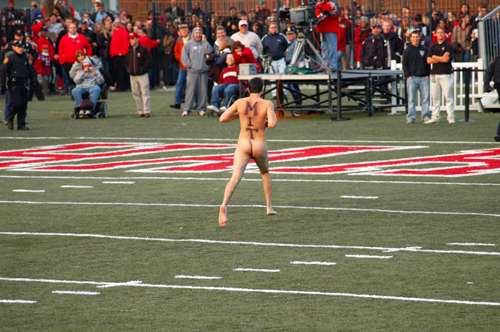Photo: Wikipedia
Streaking, a phenomenon that has captured public attention sporadically over the decades, is the act of running naked through a public place as a prank, a dare, a form of protest, or simply for the thrill. The concept of streaking taps into deeper cultural and psychological elements, blending notions of freedom, rebellion, and the breaking of societal norms. It’s a practice that, while often met with laughter or shock, can also stir controversy and provoke discussions about decency, legality, and the boundaries of public behavior.
The origins of streaking are difficult to pinpoint, as acts of public nudity for various reasons have been recorded throughout history. However, the modern act of streaking, particularly in Western societies, gained notoriety in the 1970s. This era, marked by a questioning of traditional values and an exploration of new forms of expression, saw streaking emerge as a symbol of the youth’s rebellion against the established order. Colleges and universities, with their concentrations of young adults in the throes of self-discovery, often became the epicenters of streaking incidents. These events were sometimes spontaneous, fueled by the exuberance of youth and, occasionally, alcohol; at other times, they were organized events with participants planning their routes and gathering audiences.
Public reactions to streaking have been mixed. On one hand, it’s often viewed with a sense of humor, seen as a harmless prank that breaks the monotony of daily life. Media coverage of streaking events, especially during its heyday, tended to focus on the light-hearted and humorous aspects, highlighting the surprise and amusement of unsuspecting witnesses. On the other hand, streaking can also be met with disapproval and legal consequences. Laws regarding public decency and exposure vary widely, but in many places, streaking is considered a criminal act that can result in arrest and charges of indecent exposure. Such legal repercussions underscore the tension between individual freedoms and societal norms, a balance that societies continuously negotiate.
Beyond the initial shock or amusement, streaking can be seen as a form of performance art or political statement. In some instances, streakers have used their brief moments of fame to draw attention to causes or injustices, leveraging the inevitable media coverage to broadcast messages that might otherwise go unheard. This aspect of streaking highlights how acts of rebellion can transcend mere prank or spectacle, becoming a platform for social commentary.
The motivations behind streaking are as varied as the individuals who partake in it. For some, it is an adrenaline rush, a way to feel alive and push against the boundaries of convention. For others, it is a form of expression, an assertion of individuality in a world that often demands conformity. And for a few, it is a calculated act to draw attention to a cause or issue. Regardless of the reason, streaking momentarily disrupts the routine of public life, inserting an element of unpredictability and spontaneity.
In recent years, the prevalence of smartphones and social media has changed the dynamics of streaking. What once might have been an ephemeral act, witnessed by a few and then relegated to the realm of stories and memories, can now be instantly recorded and shared with a global audience. This digital afterlife can amplify the impact of a streaking event, prolonging the discussion and debate around it, but it can also raise questions about privacy and consent.
In conclusion, streaking is more than just the act of running naked in public; it is a multifaceted phenomenon that touches on deeper themes of freedom, rebellion, and the negotiation of social norms. Its manifestations and receptions are as diverse as society itself, reflecting the changing attitudes and values of the times. Whether viewed as a harmless prank or a serious breach of law and decency, streaking undeniably holds a mirror to the complexities of human behavior and societal expectations.
Some examples of streaking:

